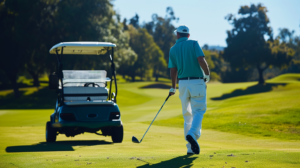Fading the golf ball is one of the most useful shot shapes, but do you truly understand what a fade is and how to hit one properly?
By learning the definition of a fade, how to hit it intentionally, practicing essential techniques like path and face control, and using intentional curves strategically, all golfers can improve scoring ability.
To unlock the advantages of this iconic shot shape, let’s dive into everything that constitutes a fade in golf.
What is a Fade Shot in Golf?
A fade is a type of golf shot that curves gently from left to right during flight for a right-handed golfer.
It is the result of the clubface being oriented to the left or open relative to the path of the swing at impact.
The difference between the open clubface angle and the swing path causes the ball to initially launch to the left of the target before curving back to the right in the air.
A fade shot, sometimes also called a controlled slice, is often hit intentionally by players but can also be the result of a mishit shot.
Compared to a straight shot, a faded golf ball will launch at a similar trajectory but then curve right due to sidespin created by the angled clubface through impact.
The amount of curvature a faded shot exhibits depends on factors like how open the clubface angle is, the relationship of the swing path to the target line, and the speed of the swing.
Players can utilize fades strategically on the course to shape shots around obstacles.
Mastering this controlled ball flight requires precise coordination of the swing fundamentals.
How to Hit a Fade
Hitting an intentional fade shot in golf requires a specific combination of set up factors, swing path, and clubface control.
Right-handed players should aim their stance slightly left of the target in consideration of the fading ball flight.
An open clubface pointed left of the aim line is also imperative to initiate sidespin on the golf ball.
During the swing, the club path should be neutral or moderately inside-out to the left.
This inside-out relationship between the swing path and the clubface angle directs the launch left before curve brings it back.
Weight shift should stay primarily steady to restrict overswing.
Adjusting the ball position, such as playing it off the back foot, can also encourage left-to-right shape on fades.
Managing these intricacies distinguishes controlled fades from unpredictable slicing.
Reasons to Hit a Fade
Fading the golf ball, when performed consistently, offers some scoring and strategic benefits for players.
Curving shots from left-to-right can enable shaping the ball away from hazards or dangerous spots on the course.
Since the clubface is open relative to club path, fade shots also launch the ball higher on a steeper trajectory which leads to added carry distance.
This makes them effective for handling crosswinds and attacking long holes.
Additionally, many golfers find playing a fade easier to control than a draw shot.
This lends itself to increased accuracy.
Golfers who struggle with hitting pulls and hooks can also benefit from the right-to-left shape of a fade to correct their ball flight.
Certain players simply feel more comfortable with shots that move gentle from left to right as it suits their swing plane and coordination.
As such, intentionally fading the ball is commonly part of game strategy.
Controlling the Fade
Executing an appropriately controlled fade requires managing several swing factors.
The face angle through impact must be manipulated to regulate the initial launch direction – a more closed clubface will start the shot closer to the target and reduce fade, while a more open face angle enhances the left-to-right side curve.
Swing path should stay neutral or slightly inside-out as too much left path causes big slices and insufficient path yields push fades.
Set up modifications can also assist fade shaping, including adjustments to ball position relative to stance.
Playing the ball back induces fading whereas forward positioning lessens it.
Additionally, club selection wields influence since longer clubs like woods accentuate fading versus shorter irons.
Weight shift should be modest – keeping stationary limits overswing and improper path.
By calibrating these specifications, players can hone repeatable fade shots for various contexts.
Common Mistakes with Fades
While a controlled fade can be useful, improper execution leads to undesirable shot outcomes and inconsistency.
A common misstep players make is having excessive openness with the clubface angle.
Too much open face relative to path creates sideways sidespin resulting in big, often uncontrollable slicing.
Conversely, an insufficiently open clubface often imparts a push fade that lacks the optimal shape.
Overly left or inside swing paths also prevent optimal ball-first contact and curve.
Swinging too far left over the top induces slices as centrifugal force redirects clubhead direction across the ball.
It helps to feel a neutral or slightly inside path for consistent ball striking.
Furthermore, poor rotational techniques, such as sliding the hips rather than turning against a steady lower body, can disrupt club delivery and accuracy.
For most golfers, suboptimal balance hampers their shot shaping capacity.
Since coordinating precise configurations of multiple swing technicalities is integral for curved shots, players often sway or lurch trying to manipulate the club.
However, solid balance enables control and consistency to master left-to-right shot bending.
What Makes a Good Fade Shot
Now that you know what a fade shot is and how to hit one, you may be wondering what constitutes a good fade.
There are several qualities that characterize an optimal fade:
Consistent Curvature
An effectively hit fade will curve a similar amount shot to shot.
This comes from ingraining the proper swing adjustments for your fade allowing reliability from both the tee and fairway.
While weather conditions affect ball flight, a dependable fade produces steady shape.
Controlled Starting Line
Since clubface angle controls launch direction, disciplined players can initiate their fade near their target line before curving right.
A good fade shouldn’t start abruptly left or right indicating likely overplaying adjustments.
Starting on line displays command of face angle and swing path unison.
Appropriate Sidespin
The clubface angle through impact imparts sidespin – too much overexposes the shot to crossing hazards while too little reduces shape predictability between shots.
An optimal fade sees enough sidespin to see the ball land right of the target but not so much that wind will excessively influence curvature.
Carry and Total Distance
Since fade shots launch higher with added carry distance compared to straight shots, good execution will maximize these assets.
Players with range restrictions can utilize high-launching, aerodynamic fades for absolute yardages off the tee.
Even into greens, properly struck fades maintain potential to stop near pin positions.
Strategic Shape
Masterful ball strikers can intentionally shape the amount of fade to match contexts like danger avoidance or wind.
A thoughtfully hit fade bends as much as a situation calls for – not under or over.
This demonstrates command over both execution and strategic course management.
By checking these boxes, players can craft one of golf’s most useful shots.
It takes practice, but disciplined reps ingrain the motor skills for carving shots around obstacles.
A compact fade transports the ball beautifully.
Drills to Practice Fade Shots
Implementing training processes expedites skill development for curved shot shaping like fades.
Targeted practice cultivates muscle memory and synchronizes the technical elements.
Golfers serious about shot versatility should regularly rehearse these fade-promoting drills:
Alignment Rod Exaggeration
Setting an alignment rod well left of the target line gives immediate feedback on swing path and clubface angles.
The visual cueing assists golfers in achieving proper orientation for launch conditions.
It also helps ingrain the feel of an in-to-out path relative to aim.
Impact Bag Feedback
Hitting a swing trainer bag builds kinesthetic awareness of clubface positions through impact.
When attempting fades, note the clubface angle as it contacts the bag and curving ball flight.
This trains optimal face orientation for sidespin generation relative to the target line.
Half-Swing Fades
Restricting the length of the backswing takes excessive motion out of the swing equation.
With compact swings, players can dedicate more focus to technical alignments and impact positions when hitting fades.
This control-based training builds confidence and consistency.
Exaggerated Stance and Setup
Setting up with an extremely closed stance to the target trains the body motion and orientation awareness which promotes draws and fades.
With feet aimed far left, players get accustomed to clearing hips for in-to-out swing paths.
The novelty also cements proper footwork for curved flight.
Impact Sheet Checking
Placing an impact sheet behind the ball and attempting to strike it with high, inward-curving swing paths gives immediate feedback on clubhead positions.
Note marks well left of ball target indicate appropriate in-to-out angle of attack for quality ball-first contact faded shots.
Regularly integrating these sorts of specialized drills builds motor patterns tailored for fade mastery.
They train the specific movement sequences and positional awareness for this unique shot shape.
Practice does not make perfect – perfect practice makes perfect.
So implement deliberate reps that reinforce execution.
Playing Strategies Using the Fade
One of the primary advantages of a fade shot, given its left-to-right flight, involves strategically avoiding course trouble off the tee and into greens.
Implementing this purposefully shaped trajectory requires some attentiveness, but pays dividends in saved strokes.
Consider these playing strategies using the fade:
Tee Shot Shaping
The tee shot imposes many scoring risks, but a disciplined fade maneuvers around dangers beautifully.
Cranking a high draw pins back flags, while a lower fade slips short of left greenside hazards.
Fade appropriately on dogleg left holes to increase driving distance thanks to minimized corner cutting.
A sound fade strategy minimizes penalties while providing ample attack angles into greens for approach.
Second Shot Fade
After finding the fairway, whether with a straight drive or other shot, players gain advantage from fading second shots around greenside defenses.
Keep the ball beneath tree canopies or play away from front bunkers with a moderate fade.
Additionally, front pins and firm greens often deflect straight shots but receive a faded approach softly.
This versatility gives more pin access for optimal scoring.
Trouble Avoidance
During any challenging hole or risky position, trust reliable fades to evade disasters.
Direct the start line away from water fronts, trees, and bunker edges.
Particularly on blind shots, assume the fade’s shape upon landing rather than hoping for a straight line near dangers.
Let the fade minimize penalties and stabilize scoring.
Its controlled bend keeps balls in play without sacrificing distance advantages.
Consistent Shot Shape
Some players struggle with manipulating multiple shot shapes mid-round.
However, dedicating focus to a go-to fade proves useful without radical adjustments.
Work this single curve precisely each hole since subtle shape variations still handle numerous contexts.
Simplify decision making and pre-shot routines through responsible, repeatable fade execution.
While straight shots seem easier, mastering intentional fade shaping unlocks immense strategy and scoring opportunities.
Curving shots left-to-right requires practice but lifts ball-striking technique and course management acumen.
A versatile fade in the bag serves all golfers tremendously.
Implement it consciously.
Conclusion
Hitting an optimal fade shot requires coordination of several swing techniques, but doing so strategically shapes shots around course trouble and lifts scoring potential.
Implement deliberate practice of essential alignments and impact mechanics to master this curve with carry distance advantages.
While no magic bullet for golf exists, a go-to fade simplifies decisions and minimizes penalties.
Learn its nuances thoughtfully through repetition.
With a reliable fade, golfers gain control and flexibility to attack pins more aggressively.
Put this shot shaping into your playing strategy.



